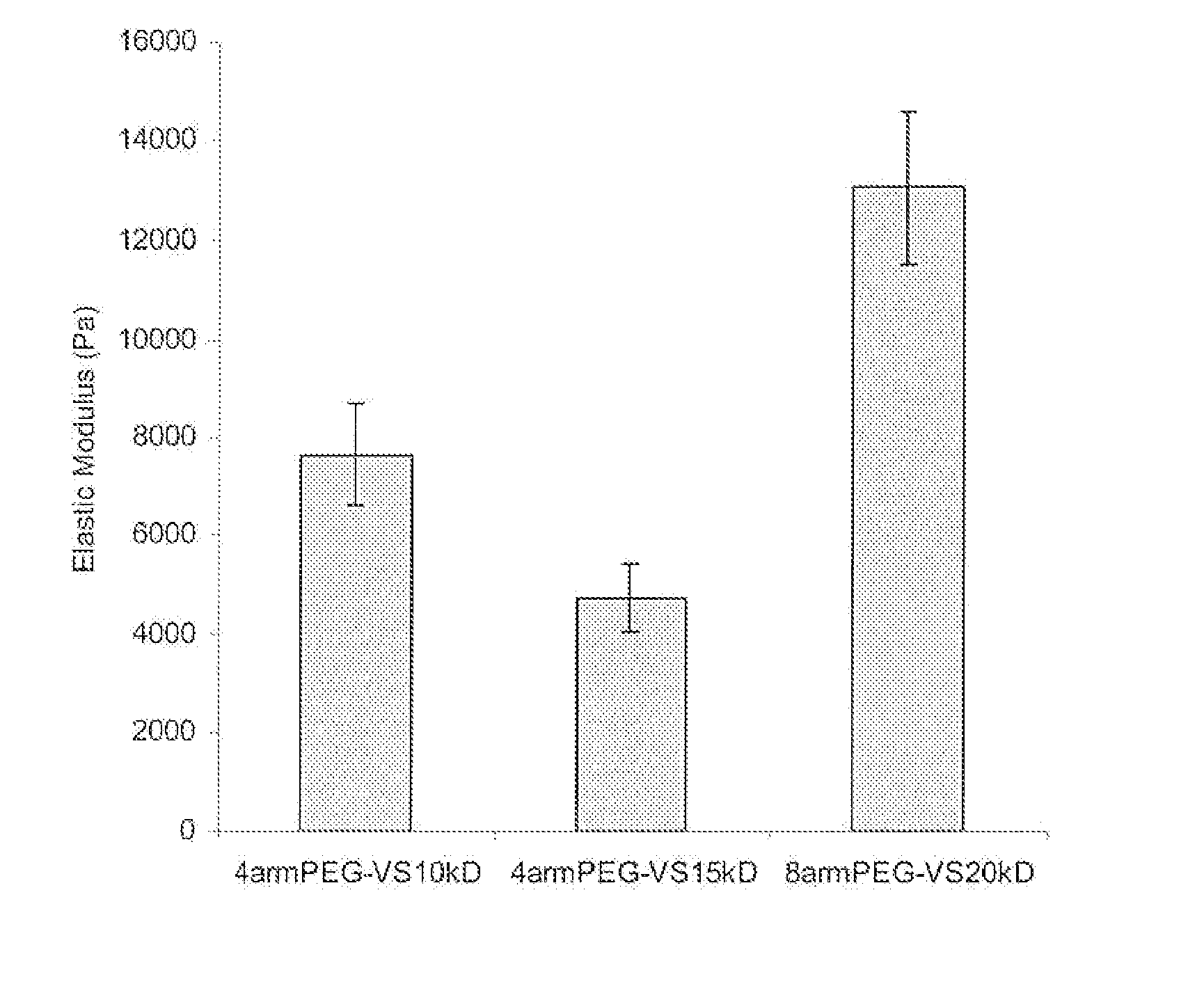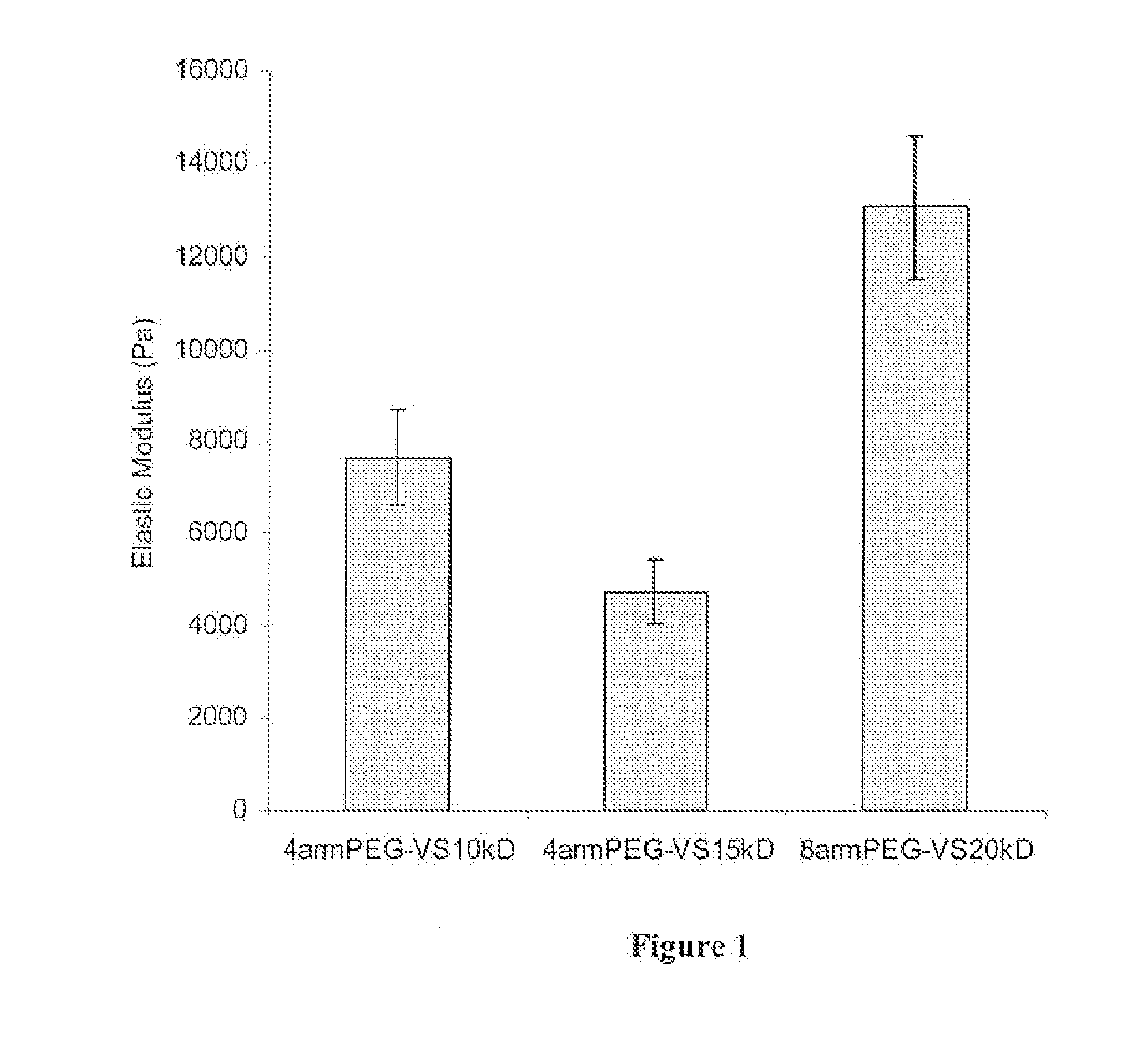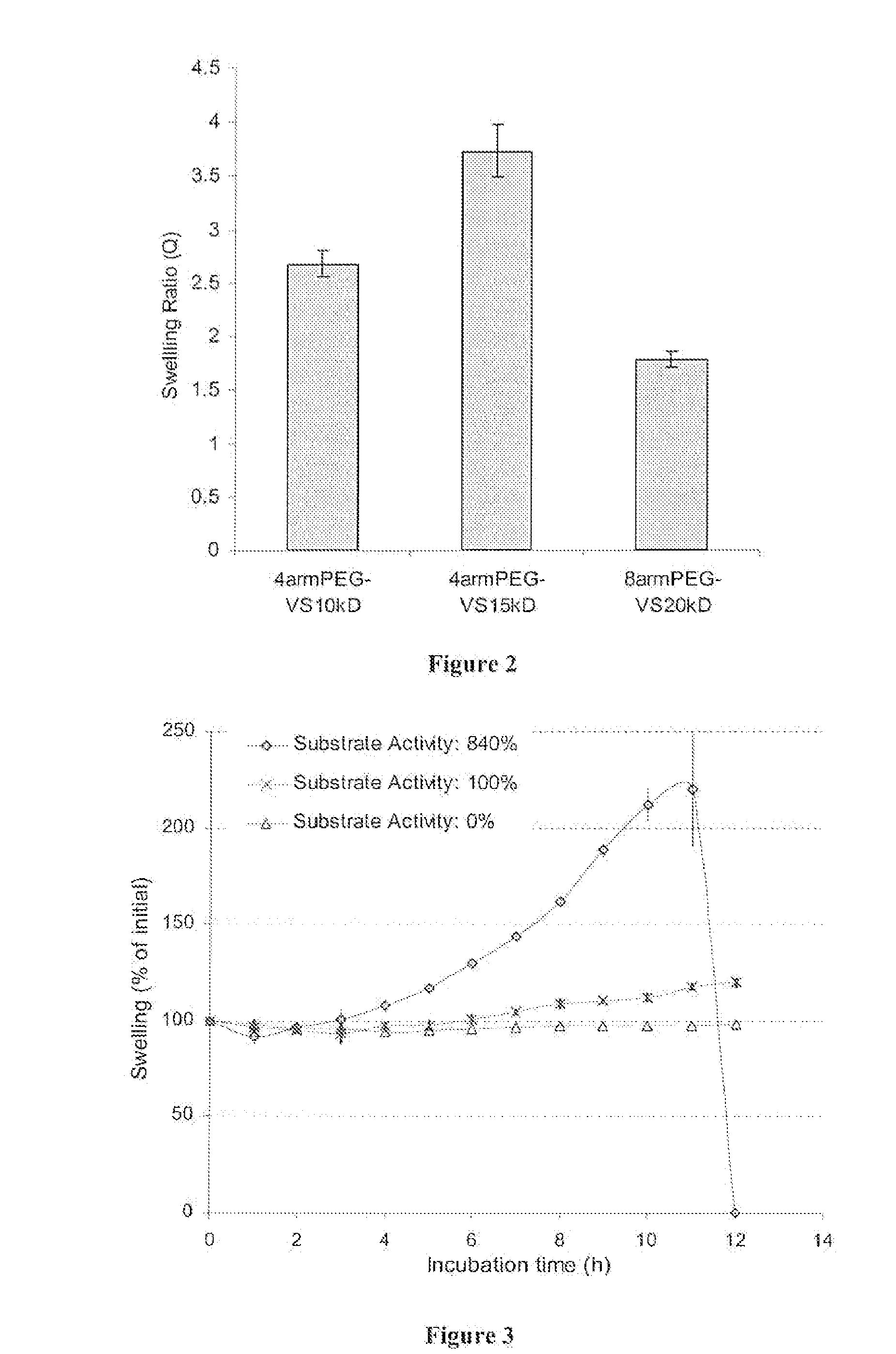Synthetic Matrix for Controlled Cell Ingrowth and Tissue Regeneration
a technology of synthetic matrices and cells, applied in the field of synthetic polymeric matrices, can solve the problems of limited availability, limited choice of chemistry, and high production costs, and achieve the effect of improving the healing capacity of synthetic matrices
- Summary
- Abstract
- Description
- Claims
- Application Information
AI Technical Summary
Benefits of technology
Problems solved by technology
Method used
Image
Examples
example 1
Preparation of Basic Reagents
[0117] Preparation of Peg-Vinylsulfones
[0118] Commercially available branched polyethylene glycols (PEGs) (4arm PEG, mol. wt. 14,800, 4arm PEG, mol. wt. 10,000 and 8arm PEG, mol. wt. 20,000; Shearwater Polymers, Huntsville, Ala., USA) were functionalized at the OH-termini.
[0119] PEG vinyl sulfones were produced under argon atmosphere by reacting a dichloromethane solution of the precursor polymers (previously dried over molecular sieves) with NaH and then, after hydrogen evolution, with divinylsulfone (molar ratios: OH 1:NaH 5:divinylsulfone 50). The reaction was carried out at room temperature for 3 days under argon with constant stirring. After the neutralization of the reaction solution with concentrated acetic acid, the solution was filtered through paper until clear. The derivatized polymer was isolated by precipitation in ice cold diethylether. The product was redissolved in dichloromethane and reprecipitated in diethylether (with thoroughly was...
example 2
Hydrogel Formation by Conjugate Addition Reactions
[0126] MMP-Sensitive Gels Formed by Conjugate Addition with a Peptide-Linked Nucleophile and a PEG-Linked Conjugated Unsaturation that Allow Proteolytic Cell Migration
[0127] The synthesis of gels is accomplished entirely through Michael-type addition reaction of thiol-PEG onto vinylsulfone-functionalized PEG. In a first step, adhesion peptides were attached pendantly (e.g. the peptide Ac-GCGYGRGDSPG-NH2) (SEQ ID NO: 4) to a multiarmed PEG-vinylsulfone and then this precursor was cross-linked with a dithiol-containing peptide (e.g. the MMP substrate Ac-GCRDGPQGIAGFDRCG-NH2) (SEQ ID NO: 5). In a typical gel preparation for 3-dimensional in vitro studies, 4arm-PEG-vinylsulfone (mol. wt. 15000) was dissolved in a TEOA buffer (0.3M, pH 8.0) to give a 10% (w / w) solution. In order to render gels cell-adhesive, the dissolved peptide Ac-GCGYGRGDSPG-NH2 (SEQ ID NO: 4) (same buffer) were added to this solution. The adhesion peptide was allowe...
example 3
Hydrogel Formation by Condensation Reactions
[0130] MMP-Sensitive Gels Formed by Condensation Reactions with a Peptide X-Linker Containing Multiple Amines and an Electrophilically Active PEG that Allow Proteolytic Cell Migration
[0131] MMP-sensitive hydrogels were also created by conducting a condensation reaction between MMP-sensitive oligopeptide containing two MMP substrates and three Lys (Ac-GKGPQGL4GQKGPQGIAGQKG-NH2) (SEQ ID NO: 7) and a commercially available (Shearwater polymers) difunctional double-ester PEG-N-hydroxysuccinimide (NHS-HBS-CM-PEG-CM-HBA-NHS). In a first step, an adhesion peptide (e.g. the peptide Ac-GCGYGRGDSPG-NH2) (SEQ ID NO: 4) was reacted with a small fraction of NHS-HBS-CM-PEG-CM-HBA-NHS and then this precursor was cross-linked to a network by mixing with the peptide Ac-GKGPQGIAGQKGPQGIAGQKG-NH2 (SEQ ID NO: 8) bearing three F-amines (and one primary amine). In a typical gel preparation for 3-dimensional in vitro studies, both molecules were dissolved in 1...
PUM
| Property | Measurement | Unit |
|---|---|---|
| Fraction | aaaaa | aaaaa |
| Fraction | aaaaa | aaaaa |
| Fraction | aaaaa | aaaaa |
Abstract
Description
Claims
Application Information
 Login to View More
Login to View More - R&D
- Intellectual Property
- Life Sciences
- Materials
- Tech Scout
- Unparalleled Data Quality
- Higher Quality Content
- 60% Fewer Hallucinations
Browse by: Latest US Patents, China's latest patents, Technical Efficacy Thesaurus, Application Domain, Technology Topic, Popular Technical Reports.
© 2025 PatSnap. All rights reserved.Legal|Privacy policy|Modern Slavery Act Transparency Statement|Sitemap|About US| Contact US: help@patsnap.com



